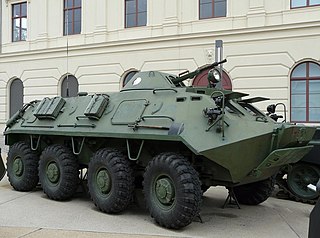
The MT-LB is a Soviet multi-purpose, fully amphibious, tracked armored fighting vehicle in use since the 1970s. It was also produced in Poland, where its YaMZ engine was replaced by a Polish 6-cylinder SW 680 diesel engine.

The BMD-1 is a Soviet airborne amphibious tracked infantry fighting vehicle (IFV), which was introduced in 1969 and first seen by the West in 1970. BMD stands for Boyevaya Mashina Desanta. It can be dropped by parachute and although it resembles the BMP-1 it is in fact much smaller. The BMD-1 was used as an IFV by the Soviet Airborne Forces (VDV). An improved variant of the BMD-1 was developed, the BMD-2. The BMD-1 also provided a basis for the BTR-D airborne multi-purpose tracked APC.

The BRDM-2 is an amphibious armoured scout car designed and developed in the Soviet Union. It was also known under the designations BTR-40PB, BTR-40P-2 and GAZ 41-08. This vehicle, like many other Soviet designs, has been exported extensively and is in use in at least 38 countries. It was intended to replace the older BRDM-1, and has improved amphibious capabilities and better armament compared to its predecessor.

The BTR-60 is the first vehicle in a series of Soviet eight-wheeled armoured personnel carriers (APCs). It was developed in the late 1950s as a replacement for the BTR-152 and was seen in public for the first time in 1961. BTR stands for bronetransportyor.

The BTR-70 is an eight-wheeled armored personnel carrier originally developed by the Soviet Union during the late 1960s under the manufacturing code GAZ-4905. On August 21, 1972, it was accepted into Soviet service and would later be widely exported. Large quantities were also produced under license in Romania as the TAB-77.

The BTR-80 is an 8×8 wheeled amphibious armoured personnel carrier (APC) designed in the Soviet Union. It was adopted in 1985 and replaced the previous vehicles, the BTR-60 and BTR-70, in the Soviet Army. It was first deployed during the Soviet–Afghan War.

The BTR-50 is a Soviet tracked amphibious armored personnel carrier (APC) based on the PT-76 light tank chassis. The BTR-50 was developed in 1952 and entered service with the Soviet Army in 1954. It ceased production in the USSR in 1970, but production continued in Czechoslovakia until 1972 and there is suggestion that it still produced by some foreign companies. It has the ability to transport up to 20 fully equipped infantrymen, and can be armed with nothing, a 7.62 mm SGMB medium machine gun, or a 14.5 mm KPV heavy machine gun. It saw notable service in the Six-Day War, the Yom Kippur War, and most recently in the Russo-Ukrainian War.

The BTR-40 is a Soviet open-topped, wheeled armoured personnel carrier and reconnaissance vehicle. It is often referred to as the Sorokovka in Soviet service. It was eventually replaced in the APC role by the BTR-152 and in the scout car role by the BRDM-1.

BTR, from Bronetransportyor/Bronetransporter, is any of a series of Soviet or post-Soviet military armoured personnel carriers (APCs).

BTR-90 (GAZ-5923) is an 8×8 wheeled armored personnel carrier developed in Russia, designed in 1993 and first shown publicly in 1994. It is a larger version of the BTR-80 vehicle, fitted with a BMP-2 turret.

The BTR-4 "Bucephalus" is an amphibious 8×8 wheeled infantry fighting vehicle (IFV) designed in Ukraine by the Kharkiv Morozov Machine Building Design Bureau.

The BTR-3 is an eight-wheel drive armored personnel carrier developed in 2000–2001 by an international consortium. The companies involved in the project include the Kharkiv Morozov Machine Building Design Bureau of Ukraine, Adcom Systems of Abu-Dhabi, UAE, and the State Scientific Technical Centre of Artillery & Rifle Arms of Ukraine. Although somewhat similar in appearance to the Soviet BTR-80, the BTR-3U is an all-new production vehicle rather than an update of the existing in-service vehicle.

The 2S9 NONA is a self-propelled and air-droppable 120 mm mortar designed in the Soviet Union, which entered service in 1981. The 2S9 chassis is designated the S-120 and based on the aluminium hull of the BTR-D airborne multi-purpose tracked armoured personnel carrier. More generally, the 120 mm mortar is referred to as the Nona, with the 2S9 also known as the Nona-S. Although no figures have been released, it is estimated that well over 1,000 2S9 were built.

The OT-62 TOPAS is a series of amphibious tracked armoured personnel carriers developed jointly by Polish People's Republic and Czechoslovakia (ČSSR). OT-62 stands for Obrněný Transportér vzor 62 – "armoured personnel carrier model 62". TOPAS stands for Transportér Obrněný Pásový – "tracked armoured personnel carrier".

The Fahd is a 4x4 Egyptian armored personnel carrier, designed to fit the requirements of the Egyptian Military. It replaced older APCs in Egyptian service such as the BTR-40, and the Walid. It has been used by the United Nations.

The ZSU-23-4 "Shilka" is a lightly armored Soviet self-propelled, radar-guided anti-aircraft weapon system (SPAAG). It was superseded by the 9K22 Tunguska.

The BMD-4 is an amphibious infantry fighting vehicle (IFV) originating from post-Cold War Russia. Originally designated as the BMD-3M, the chassis of the BMD-4 is the same as that of the BMD-3 because it was developed on the same basis. This armored fighting vehicle is one of the lightest in its class, possessing a substantial amount of firepower. The vehicle was designed to transport Russian Airborne Troops (VDV), increasing its mobility, armament, and protection on the battlefield.

The BTR-70DI is a Ukrainian upgrade of the Soviet BTR-70 with BTR-80 hatch and new diesel engines.



















